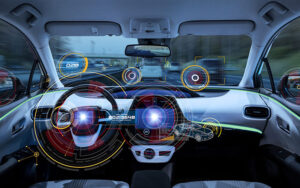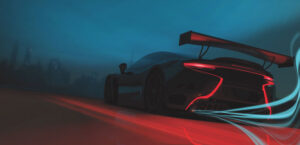by Sean Leavy, regional product manager, Americas, Branson Assembly and Welding technologies at Emerson
These are good times for product designers as new materials and technologies open up creative opportunities for multidimensional plastic parts – both large and small. This is particularly true in automotive lighting.
Consider, for instance, the center taillamp designs on many of today’s high-end automobiles. The small individual structures that were standard equipment on the rear ends of most vehicles rapidly are giving way to high-style designs. New center taillamp designs for today’s automobiles are bigger, often up to 1500 mm, and their 3D shapes are highly decorative and mostly visible.
However, as center lamp assemblies and other highly visible lighting components elsewhere on vehicles have become more sophisticated, auto designers and lighting suppliers have discovered that conventional plastic welding techniques fall short of their elevated quality and production goals. That is because these designs require superior weld strength and aesthetics, including clean, precise weld lines with no flash, while avoiding damage to delicate built-in electronics.
Compact organic light-emitting-diodes (OLEDs) are LEDs mounted to a single, compact electrical panel inside these lamps. They generate extremely bright displays that do not generate the high temperatures typical of old incandescent or even halogen technologies. This means that a lot of illumination can be built into various structures while, at the same time, advanced assembly technology is making it possible to build automotive lighting fixtures that are bigger and more beautiful than ever.
As automakers seek to create a more customized and comfortable atmosphere for the driver and passengers, interior lighting also is changing. Instead of just a few individual lamps to facilitate entry and exit or to illuminate maps, interior lighting today is migrating toward softer “mood” and even “smart” lighting. As drivers approach the cars, key fobs communicate with sensors, turning on internal illumination to welcome them.
These also make extensive use of plastics in sealed assemblies. Driver-information displays now are a key design element in automobile interiors. From dashboard instruments to interactive maps and satellite radio selections, these displays ultimately are connected to almost every possible sensor and camera in the car. The outer plastic housings require joining, as do many of the circuit boards and wired assemblies inside the console.
The same thing is happening in nonautomotive applications. Wearable medical devices are another good example. Heart-rate and blood-pressure monitors, insulin-delivery devices and even fitness trackers are precision 3D assemblies that incorporate sophisticated electronics. Since they usually are visible when worn, aesthetics are critically important. Consumer and business electronics like miniature audio devices, telephones, cameras and touchscreen devices all demand durable, hermetically sealed welds that meet the highest standards for style.
Take today’s advanced cellphone camera lenses, for instance. This is a 3D application at the other dimensional extreme from automotive taillights, and yet it is probably even more complex and demanding. That is because a cellphone camera lens is not just one piece. In fact, it is an assembly of multiple lenses – to make it possible to take standard, micro and telephoto shots – plus spacers and a shield, all welded together into a tiny housing along with the required electronics.
Clean welding technology answers the challenges

Proven welding techniques like ultrasonics, spin welding and conventional vibration work well in simpler applications that do not involve 3D shapes or include delicate electronics that can be damaged by the high-frequency motion needed to complete the bond. However, there are “clean” processes that are creating exciting new opportunities.
Three such processes are of particular importance in complex 3D assemblies. These include Contoured Laser Technology (CLT), Clean Vibration Technology (CVT) and PulseStaking.
These processes deliver clean, clear, weld-bead aesthetics, virtually free of the particulates and “angel hair” that can undermine aesthetics, require downstream manufacturing to remove flake-off or compromise end-product performance.
Other benefits include engineering design flexibility that allows weld lines to be part of the product design, even in complex parts, and faster, more efficient welding that saves time and energy used in the joining process.
How they work
Contoured Laser Technology (CLT) is ideal for welding entire assemblies that incorporate not only the plastic components but also sophisticated lighting, delicate sensors, cameras, scanners or other electronics components that could be damaged by the mechanical motion of ultrasonics and other less versatile techniques.
CLT involves multiple beams, positioned on many axes, so that the energy is delivered along the full length of the weld surface at once. One surface freely transmits the laser energy (without itself being affected) through to an absorptive surface that converts the laser to heat. That heat conducts across the interface, melting both parts and creating weld depths typically between 0.2 mm and 0.8 mm. Thicker and thinner welds have been achieved consistently when necessary.
Lasers are remarkably versatile. They can weld dozens of different polymers, including some of the most advanced engineering materials. They even can be used with otherwise incompatible resins, including crystalline and amorphous resins, as well as reinforced plastics.
Usually, the transmissive surface is more or less clear, and the absorptive layer is darker, but that does not always have to be the case. Using various coatings and additives, an otherwise laser-transparent material can be made to absorb laser radiation, making it possible to create clear-on-clear assemblies.
Contoured laser technology is a distinctly different approach from trace or scan lasers that must travel the entire length of the weld line, completing the weld a little at a time, as a moving pressure device that can be thrown off by part imperfections and poor tolerances. Instead, the entire part is assembled while placed in a pressure-controlled clamping tooling before the laser energy is applied. Laser-emitting wave guides are configured in 3D to conform exactly to the geometry of the part surfaces they are to join.
For instance, when assembling OLEDs into a taillamp, all the welds must be completed at the same time and in different geometric planes. Then, that inner structure must be joined to the outer shell through which the different LEDs shine to indicate braking or turning, or to illuminate the area around the car as it backs up.
Clean Vibration Technology represents an alternative to laser welding but delivers many of the same benefits. Unlike more conventional vibration or ultrasonic welding, the heat energy required to melt and weld the components is reached during an infrared preheating operation that plasticizes the weld line. Only then are the two components brought together under pressure so that vibration can complete the weld. This two-step process requires no solid-solid friction, which ensures uniform material flow and prevents particulate generation. Once optimal weld depth is reached, vibration stops and joined parts cool into a single, clean-vibration joint, with no “angel hair” byproduct and with excellent mechanical properties. Because the vibration portion of the process is less intense, there is much less chance of damaging delicate embedded components.

Applications – automobile taillights, other lighting fixtures, or any part or product that requires a clean weld that maximizes aesthetics, integrity or functionality – are similar to those accomplished with contoured laser technology. Thus, automotive suppliers – and others with similar demands for clean, strong 3D assemblies – have a choice of welding processes that helps them balance productivity and innovation with rigorous design, quality and material demands.
PulseStaking Technology is especially advantageous when it comes to arranging and securing many small and sensitive electronic items into component-dense plastic structures in automotive, medical and electronics applications, where its value and ROI have been firmly established.
Staking involves placing components onto small posts in a plastic part, then reforming or “staking” the exposed posts using heat and force into flattened, rivet-like disks that lock the components in place. Thermoplastic stakes can be made quickly and at relatively low cost, capturing and securing components made from many materials: plastics, glass-reinforced polymers, metals, ceramics, fabrics and filter media, printed circuit boards (PCBs), switches and electronics.
Developed by HTE Engineering Services Ltd., which was acquired in October 2018 by Emerson, PulseStaking uses and applies heat selectively, heating and cooling instantly and only when needed. Heat is applied in a highly controlled and localized manner, a significant advance over earlier thermal staking tools that continuously radiate high heat in all directions before, during and after a stake. Thus, it is readily applicable to securing multiple, closely spaced features on geometrically complex 3D parts.
A single piece of tooling can accommodate multiple PulseStaking tips, enabling them to perform multiple stakes on parts or assemblies (using different temperatures and cooling rates, if needed) at the same time. A single PulseStaking machine can support the operation of up to 60 different tips.
Conclusion
As the industry adapts toward more “clean” plastics welding technologies, it opens the door for new aesthetic opportunities in complex, 3D assemblies. By understanding how these technologies not only benefit the everchanging industry, but also the consumers, the possibilities become endless. Contoured Laser Technology (CLT), Clean Vibration Technology (CVT) and PulseStaking are only the beginning in 3D assembly. As times change, the opportunity for new technologies to expand the assembly line are inevitable and exciting.
 Sean Leavy is the regional product manager, Americas, Branson Assembly and Welding technologies at Emerson. He is responsible for implementing global marketing and product strategy for laser welding and other products in the Branson assembly technology portfolio. Leavy has an MBA from Simon at the University of Rochester, New York. Branson welding technologies can help improve every part of the production and performance of large (and small) components, no matter how complex. The process-neutral range of Emerson plastic welding technologies offers more options and applications for smarter joint design, providing long-term durability and performance. For more information, visit www.emerson.com.
Sean Leavy is the regional product manager, Americas, Branson Assembly and Welding technologies at Emerson. He is responsible for implementing global marketing and product strategy for laser welding and other products in the Branson assembly technology portfolio. Leavy has an MBA from Simon at the University of Rochester, New York. Branson welding technologies can help improve every part of the production and performance of large (and small) components, no matter how complex. The process-neutral range of Emerson plastic welding technologies offers more options and applications for smarter joint design, providing long-term durability and performance. For more information, visit www.emerson.com.


